Managing Human Resources: Multinational and Transnational Enterprises, Staffing Approaches, Collective Bargaining, and Labour Laws
VerifiedAdded on 2023/06/15
|9
|2763
|161
AI Summary
This report discusses the difference between multinational and transnational enterprises, key differences between IHRM and HRM, approaches of staffing, advantages of regiocentrism, disadvantages of polycentrism, difference between collective bargaining of UK and Germany, importance of understanding national culture, key factors of recruitment and selection, recommendations on key management development initiatives, proposal and recommendations on policies and procedures of repatriation, outlining the policies and procedures of organization at the time of transfer, and the differences and similarities of labour laws.
Contribute Materials
Your contribution can guide someone’s learning journey. Share your
documents today.
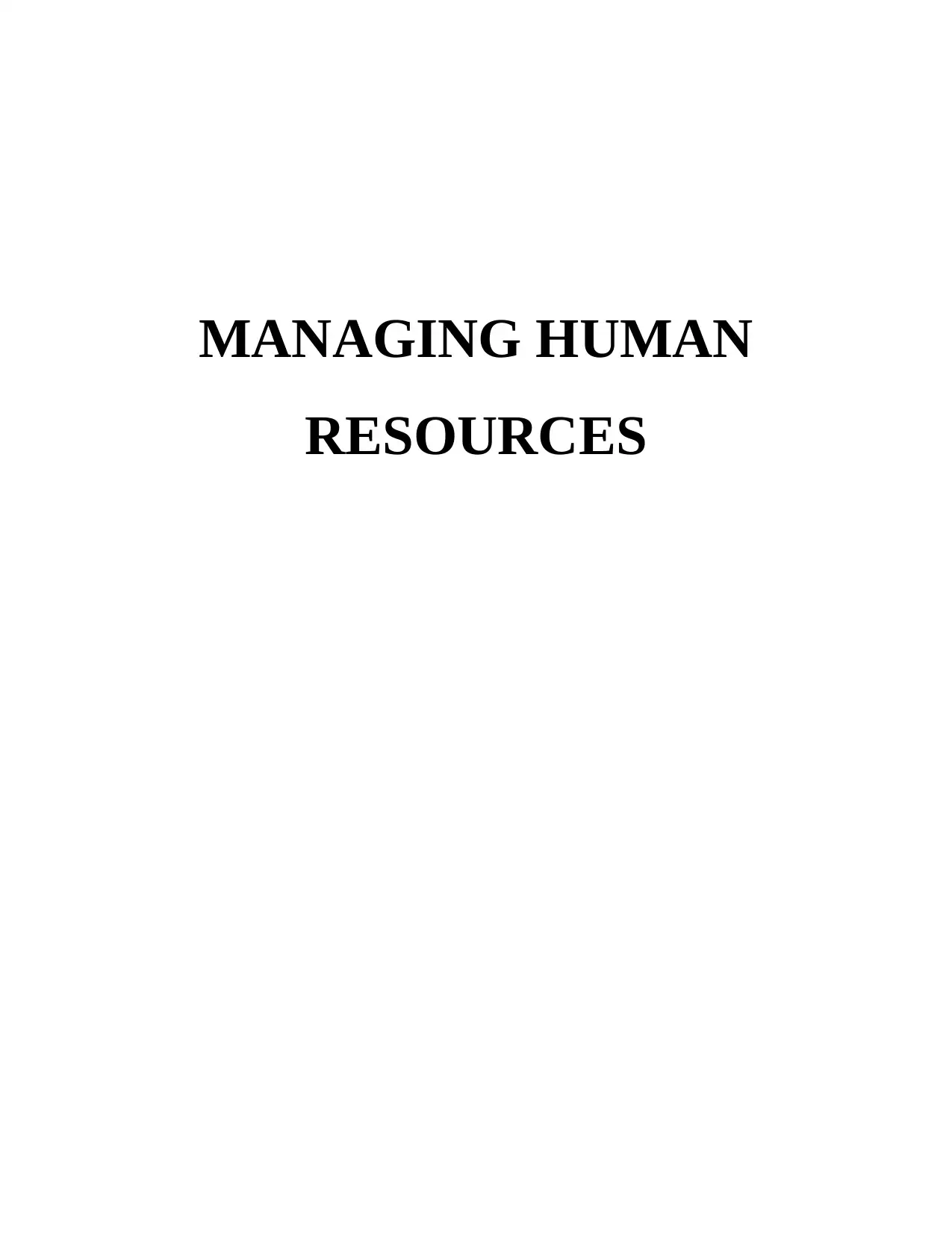
MANAGING HUMAN
RESOURCES
RESOURCES
Secure Best Marks with AI Grader
Need help grading? Try our AI Grader for instant feedback on your assignments.
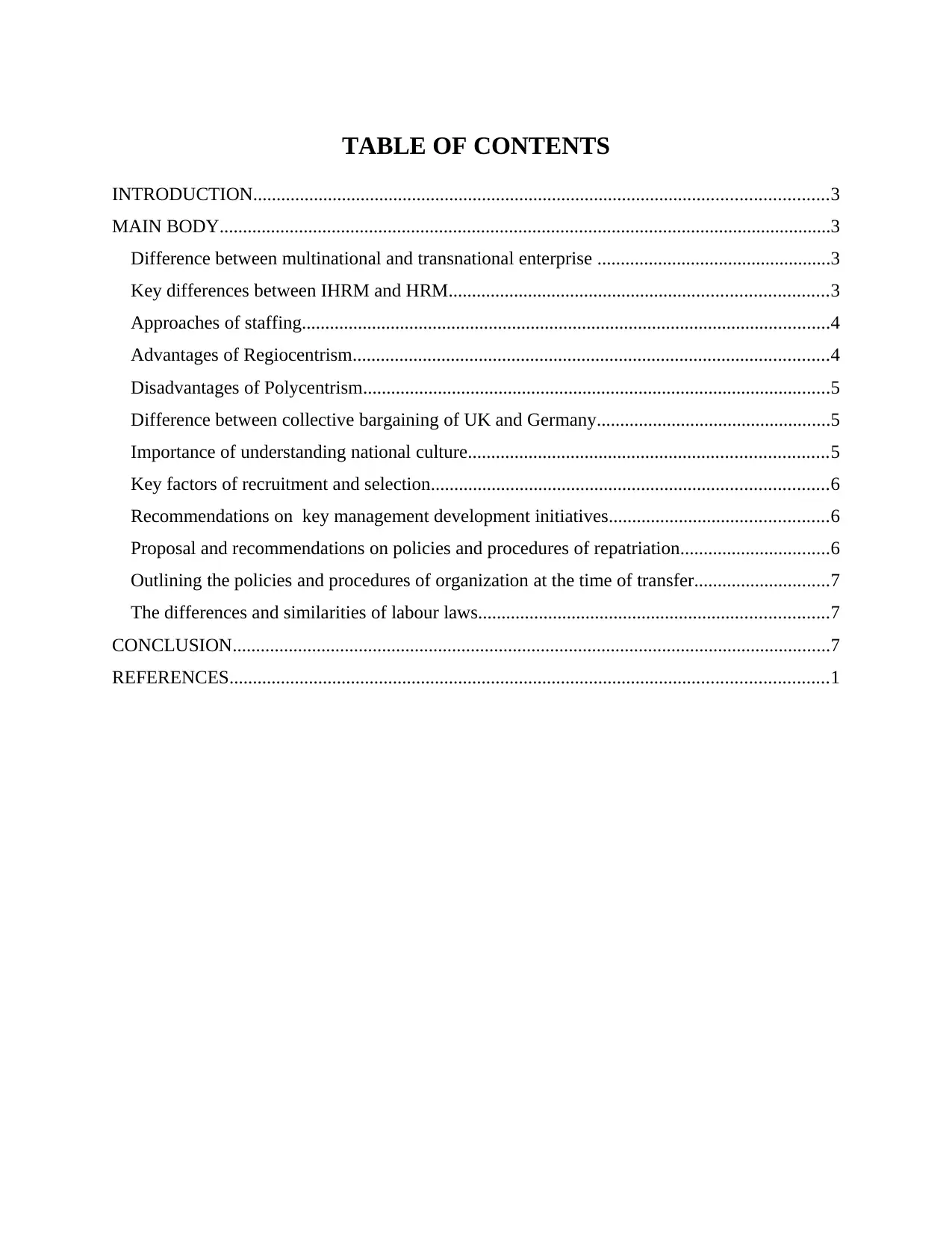
TABLE OF CONTENTS
INTRODUCTION...........................................................................................................................3
MAIN BODY...................................................................................................................................3
Difference between multinational and transnational enterprise ..................................................3
Key differences between IHRM and HRM.................................................................................3
Approaches of staffing.................................................................................................................4
Advantages of Regiocentrism......................................................................................................4
Disadvantages of Polycentrism....................................................................................................5
Difference between collective bargaining of UK and Germany..................................................5
Importance of understanding national culture.............................................................................5
Key factors of recruitment and selection.....................................................................................6
Recommendations on key management development initiatives...............................................6
Proposal and recommendations on policies and procedures of repatriation................................6
Outlining the policies and procedures of organization at the time of transfer.............................7
The differences and similarities of labour laws...........................................................................7
CONCLUSION................................................................................................................................7
REFERENCES................................................................................................................................1
INTRODUCTION...........................................................................................................................3
MAIN BODY...................................................................................................................................3
Difference between multinational and transnational enterprise ..................................................3
Key differences between IHRM and HRM.................................................................................3
Approaches of staffing.................................................................................................................4
Advantages of Regiocentrism......................................................................................................4
Disadvantages of Polycentrism....................................................................................................5
Difference between collective bargaining of UK and Germany..................................................5
Importance of understanding national culture.............................................................................5
Key factors of recruitment and selection.....................................................................................6
Recommendations on key management development initiatives...............................................6
Proposal and recommendations on policies and procedures of repatriation................................6
Outlining the policies and procedures of organization at the time of transfer.............................7
The differences and similarities of labour laws...........................................................................7
CONCLUSION................................................................................................................................7
REFERENCES................................................................................................................................1
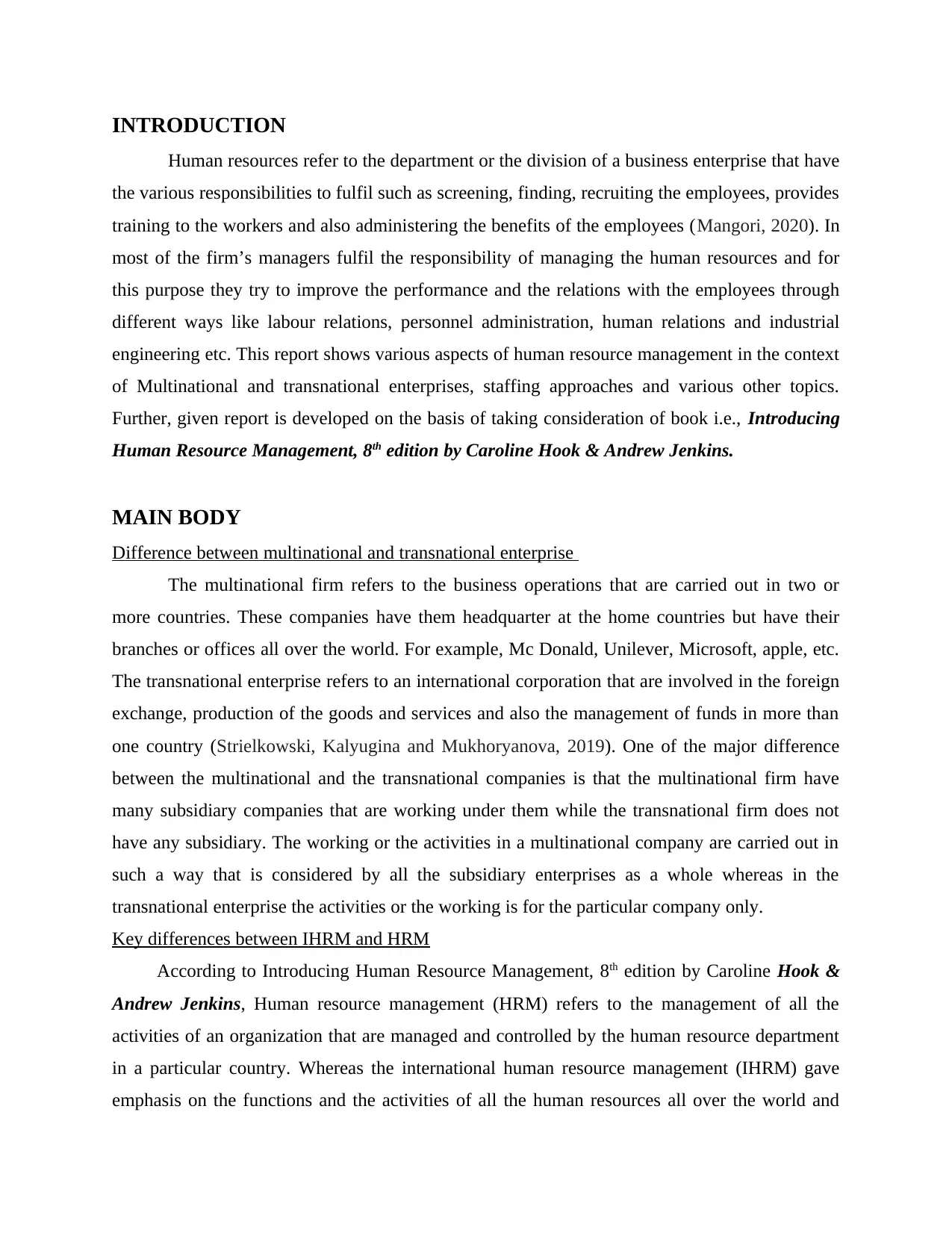
INTRODUCTION
Human resources refer to the department or the division of a business enterprise that have
the various responsibilities to fulfil such as screening, finding, recruiting the employees, provides
training to the workers and also administering the benefits of the employees (Mangori, 2020). In
most of the firm’s managers fulfil the responsibility of managing the human resources and for
this purpose they try to improve the performance and the relations with the employees through
different ways like labour relations, personnel administration, human relations and industrial
engineering etc. This report shows various aspects of human resource management in the context
of Multinational and transnational enterprises, staffing approaches and various other topics.
Further, given report is developed on the basis of taking consideration of book i.e., Introducing
Human Resource Management, 8th edition by Caroline Hook & Andrew Jenkins.
MAIN BODY
Difference between multinational and transnational enterprise
The multinational firm refers to the business operations that are carried out in two or
more countries. These companies have them headquarter at the home countries but have their
branches or offices all over the world. For example, Mc Donald, Unilever, Microsoft, apple, etc.
The transnational enterprise refers to an international corporation that are involved in the foreign
exchange, production of the goods and services and also the management of funds in more than
one country (Strielkowski, Kalyugina and Mukhoryanova, 2019). One of the major difference
between the multinational and the transnational companies is that the multinational firm have
many subsidiary companies that are working under them while the transnational firm does not
have any subsidiary. The working or the activities in a multinational company are carried out in
such a way that is considered by all the subsidiary enterprises as a whole whereas in the
transnational enterprise the activities or the working is for the particular company only.
Key differences between IHRM and HRM
According to Introducing Human Resource Management, 8th edition by Caroline Hook &
Andrew Jenkins, Human resource management (HRM) refers to the management of all the
activities of an organization that are managed and controlled by the human resource department
in a particular country. Whereas the international human resource management (IHRM) gave
emphasis on the functions and the activities of all the human resources all over the world and
Human resources refer to the department or the division of a business enterprise that have
the various responsibilities to fulfil such as screening, finding, recruiting the employees, provides
training to the workers and also administering the benefits of the employees (Mangori, 2020). In
most of the firm’s managers fulfil the responsibility of managing the human resources and for
this purpose they try to improve the performance and the relations with the employees through
different ways like labour relations, personnel administration, human relations and industrial
engineering etc. This report shows various aspects of human resource management in the context
of Multinational and transnational enterprises, staffing approaches and various other topics.
Further, given report is developed on the basis of taking consideration of book i.e., Introducing
Human Resource Management, 8th edition by Caroline Hook & Andrew Jenkins.
MAIN BODY
Difference between multinational and transnational enterprise
The multinational firm refers to the business operations that are carried out in two or
more countries. These companies have them headquarter at the home countries but have their
branches or offices all over the world. For example, Mc Donald, Unilever, Microsoft, apple, etc.
The transnational enterprise refers to an international corporation that are involved in the foreign
exchange, production of the goods and services and also the management of funds in more than
one country (Strielkowski, Kalyugina and Mukhoryanova, 2019). One of the major difference
between the multinational and the transnational companies is that the multinational firm have
many subsidiary companies that are working under them while the transnational firm does not
have any subsidiary. The working or the activities in a multinational company are carried out in
such a way that is considered by all the subsidiary enterprises as a whole whereas in the
transnational enterprise the activities or the working is for the particular company only.
Key differences between IHRM and HRM
According to Introducing Human Resource Management, 8th edition by Caroline Hook &
Andrew Jenkins, Human resource management (HRM) refers to the management of all the
activities of an organization that are managed and controlled by the human resource department
in a particular country. Whereas the international human resource management (IHRM) gave
emphasis on the functions and the activities of all the human resources all over the world and
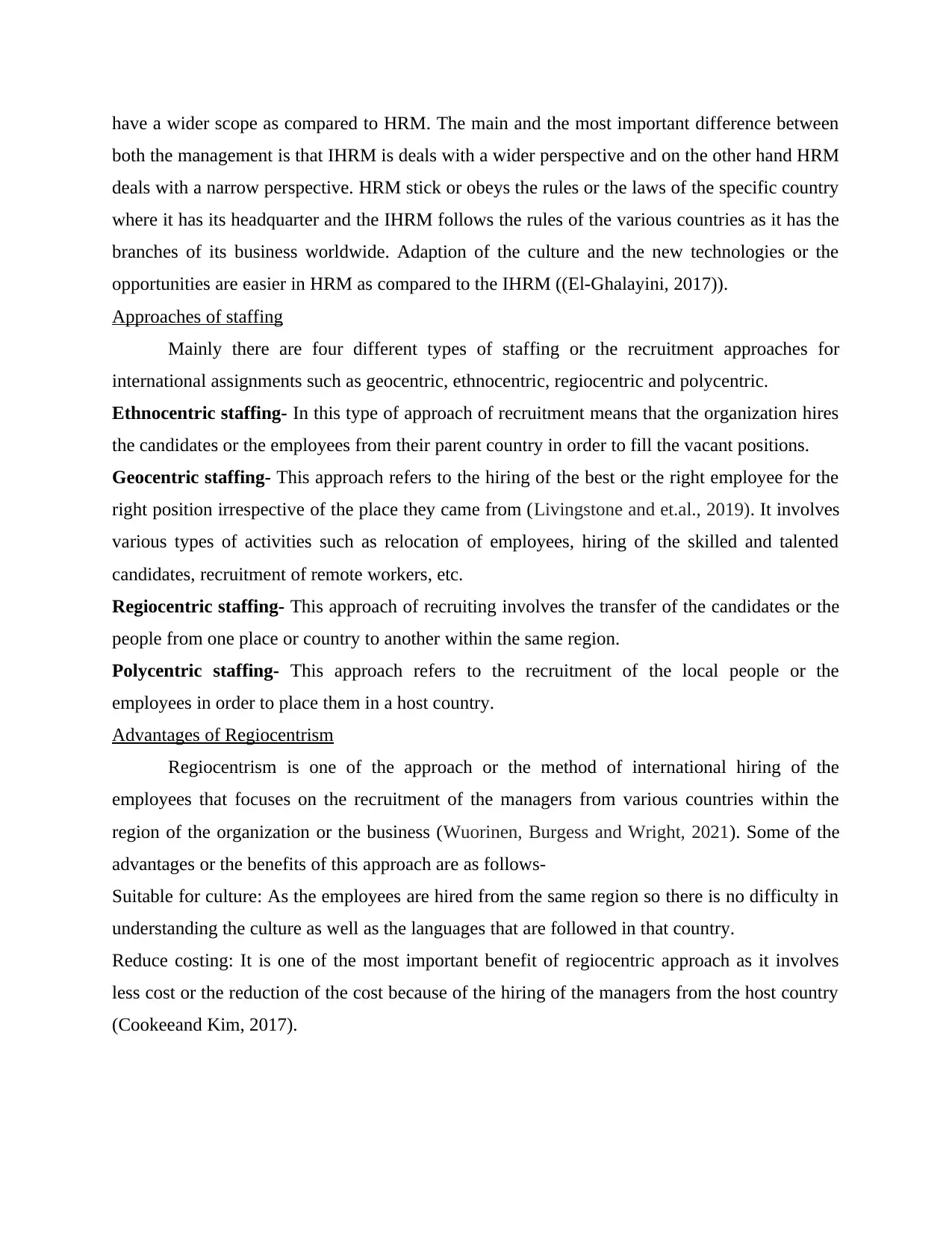
have a wider scope as compared to HRM. The main and the most important difference between
both the management is that IHRM is deals with a wider perspective and on the other hand HRM
deals with a narrow perspective. HRM stick or obeys the rules or the laws of the specific country
where it has its headquarter and the IHRM follows the rules of the various countries as it has the
branches of its business worldwide. Adaption of the culture and the new technologies or the
opportunities are easier in HRM as compared to the IHRM ((El-Ghalayini, 2017)).
Approaches of staffing
Mainly there are four different types of staffing or the recruitment approaches for
international assignments such as geocentric, ethnocentric, regiocentric and polycentric.
Ethnocentric staffing- In this type of approach of recruitment means that the organization hires
the candidates or the employees from their parent country in order to fill the vacant positions.
Geocentric staffing- This approach refers to the hiring of the best or the right employee for the
right position irrespective of the place they came from (Livingstone and et.al., 2019). It involves
various types of activities such as relocation of employees, hiring of the skilled and talented
candidates, recruitment of remote workers, etc.
Regiocentric staffing- This approach of recruiting involves the transfer of the candidates or the
people from one place or country to another within the same region.
Polycentric staffing- This approach refers to the recruitment of the local people or the
employees in order to place them in a host country.
Advantages of Regiocentrism
Regiocentrism is one of the approach or the method of international hiring of the
employees that focuses on the recruitment of the managers from various countries within the
region of the organization or the business (Wuorinen, Burgess and Wright, 2021). Some of the
advantages or the benefits of this approach are as follows-
Suitable for culture: As the employees are hired from the same region so there is no difficulty in
understanding the culture as well as the languages that are followed in that country.
Reduce costing: It is one of the most important benefit of regiocentric approach as it involves
less cost or the reduction of the cost because of the hiring of the managers from the host country
(Cookeeand Kim, 2017).
both the management is that IHRM is deals with a wider perspective and on the other hand HRM
deals with a narrow perspective. HRM stick or obeys the rules or the laws of the specific country
where it has its headquarter and the IHRM follows the rules of the various countries as it has the
branches of its business worldwide. Adaption of the culture and the new technologies or the
opportunities are easier in HRM as compared to the IHRM ((El-Ghalayini, 2017)).
Approaches of staffing
Mainly there are four different types of staffing or the recruitment approaches for
international assignments such as geocentric, ethnocentric, regiocentric and polycentric.
Ethnocentric staffing- In this type of approach of recruitment means that the organization hires
the candidates or the employees from their parent country in order to fill the vacant positions.
Geocentric staffing- This approach refers to the hiring of the best or the right employee for the
right position irrespective of the place they came from (Livingstone and et.al., 2019). It involves
various types of activities such as relocation of employees, hiring of the skilled and talented
candidates, recruitment of remote workers, etc.
Regiocentric staffing- This approach of recruiting involves the transfer of the candidates or the
people from one place or country to another within the same region.
Polycentric staffing- This approach refers to the recruitment of the local people or the
employees in order to place them in a host country.
Advantages of Regiocentrism
Regiocentrism is one of the approach or the method of international hiring of the
employees that focuses on the recruitment of the managers from various countries within the
region of the organization or the business (Wuorinen, Burgess and Wright, 2021). Some of the
advantages or the benefits of this approach are as follows-
Suitable for culture: As the employees are hired from the same region so there is no difficulty in
understanding the culture as well as the languages that are followed in that country.
Reduce costing: It is one of the most important benefit of regiocentric approach as it involves
less cost or the reduction of the cost because of the hiring of the managers from the host country
(Cookeeand Kim, 2017).
Secure Best Marks with AI Grader
Need help grading? Try our AI Grader for instant feedback on your assignments.
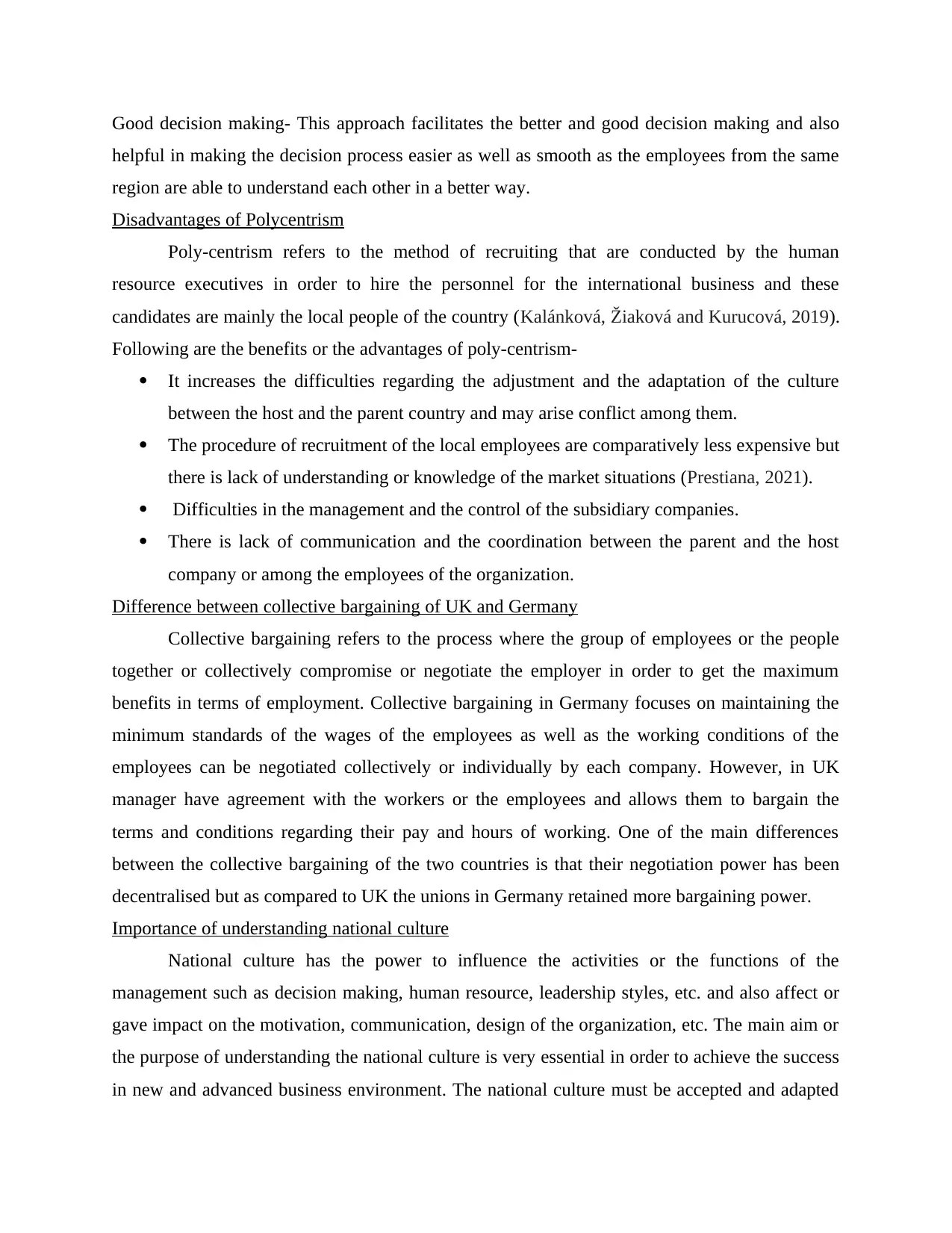
Good decision making- This approach facilitates the better and good decision making and also
helpful in making the decision process easier as well as smooth as the employees from the same
region are able to understand each other in a better way.
Disadvantages of Polycentrism
Poly-centrism refers to the method of recruiting that are conducted by the human
resource executives in order to hire the personnel for the international business and these
candidates are mainly the local people of the country (Kalánková, Žiaková and Kurucová, 2019).
Following are the benefits or the advantages of poly-centrism-
It increases the difficulties regarding the adjustment and the adaptation of the culture
between the host and the parent country and may arise conflict among them.
The procedure of recruitment of the local employees are comparatively less expensive but
there is lack of understanding or knowledge of the market situations (Prestiana, 2021).
Difficulties in the management and the control of the subsidiary companies.
There is lack of communication and the coordination between the parent and the host
company or among the employees of the organization.
Difference between collective bargaining of UK and Germany
Collective bargaining refers to the process where the group of employees or the people
together or collectively compromise or negotiate the employer in order to get the maximum
benefits in terms of employment. Collective bargaining in Germany focuses on maintaining the
minimum standards of the wages of the employees as well as the working conditions of the
employees can be negotiated collectively or individually by each company. However, in UK
manager have agreement with the workers or the employees and allows them to bargain the
terms and conditions regarding their pay and hours of working. One of the main differences
between the collective bargaining of the two countries is that their negotiation power has been
decentralised but as compared to UK the unions in Germany retained more bargaining power.
Importance of understanding national culture
National culture has the power to influence the activities or the functions of the
management such as decision making, human resource, leadership styles, etc. and also affect or
gave impact on the motivation, communication, design of the organization, etc. The main aim or
the purpose of understanding the national culture is very essential in order to achieve the success
in new and advanced business environment. The national culture must be accepted and adapted
helpful in making the decision process easier as well as smooth as the employees from the same
region are able to understand each other in a better way.
Disadvantages of Polycentrism
Poly-centrism refers to the method of recruiting that are conducted by the human
resource executives in order to hire the personnel for the international business and these
candidates are mainly the local people of the country (Kalánková, Žiaková and Kurucová, 2019).
Following are the benefits or the advantages of poly-centrism-
It increases the difficulties regarding the adjustment and the adaptation of the culture
between the host and the parent country and may arise conflict among them.
The procedure of recruitment of the local employees are comparatively less expensive but
there is lack of understanding or knowledge of the market situations (Prestiana, 2021).
Difficulties in the management and the control of the subsidiary companies.
There is lack of communication and the coordination between the parent and the host
company or among the employees of the organization.
Difference between collective bargaining of UK and Germany
Collective bargaining refers to the process where the group of employees or the people
together or collectively compromise or negotiate the employer in order to get the maximum
benefits in terms of employment. Collective bargaining in Germany focuses on maintaining the
minimum standards of the wages of the employees as well as the working conditions of the
employees can be negotiated collectively or individually by each company. However, in UK
manager have agreement with the workers or the employees and allows them to bargain the
terms and conditions regarding their pay and hours of working. One of the main differences
between the collective bargaining of the two countries is that their negotiation power has been
decentralised but as compared to UK the unions in Germany retained more bargaining power.
Importance of understanding national culture
National culture has the power to influence the activities or the functions of the
management such as decision making, human resource, leadership styles, etc. and also affect or
gave impact on the motivation, communication, design of the organization, etc. The main aim or
the purpose of understanding the national culture is very essential in order to achieve the success
in new and advanced business environment. The national culture must be accepted and adapted
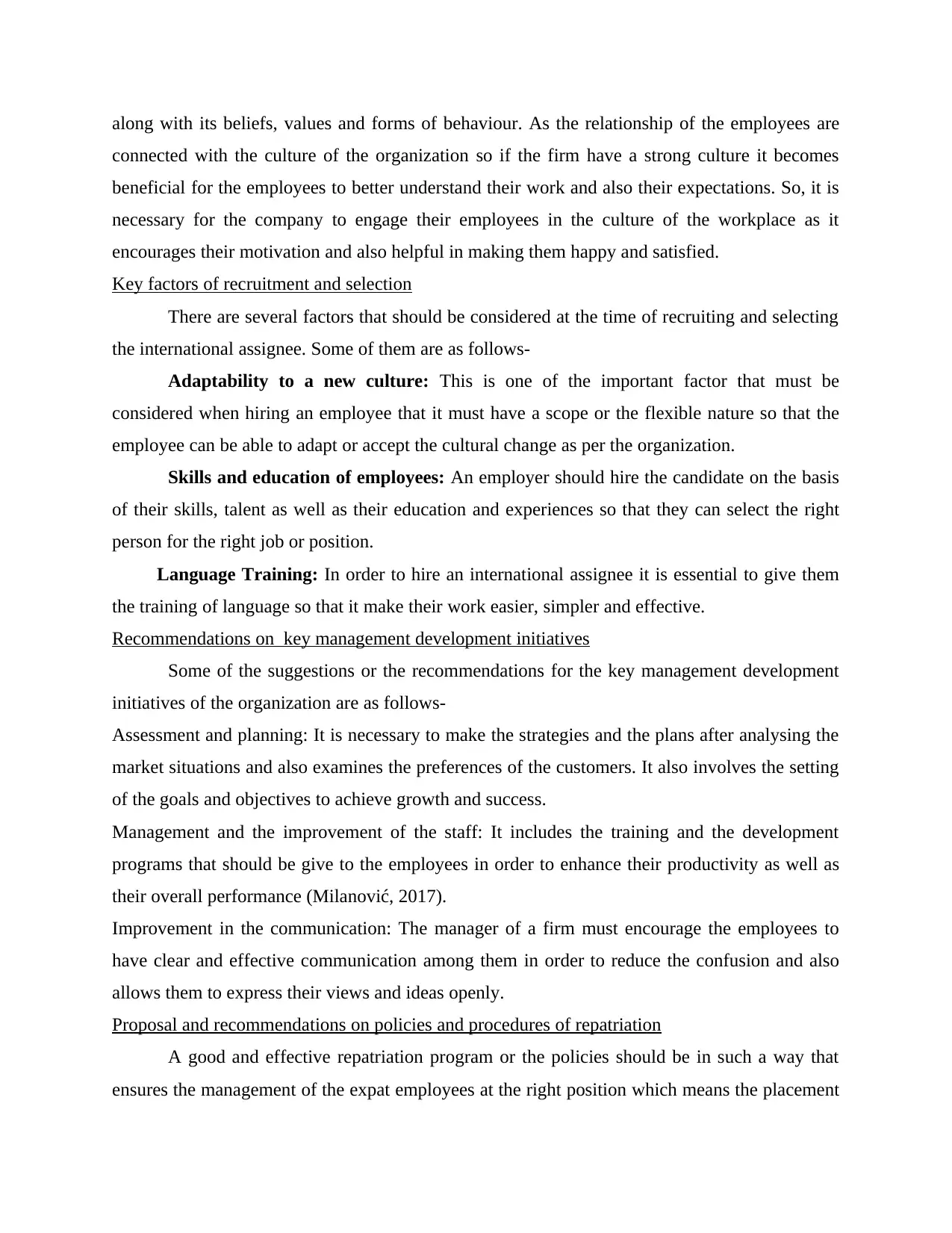
along with its beliefs, values and forms of behaviour. As the relationship of the employees are
connected with the culture of the organization so if the firm have a strong culture it becomes
beneficial for the employees to better understand their work and also their expectations. So, it is
necessary for the company to engage their employees in the culture of the workplace as it
encourages their motivation and also helpful in making them happy and satisfied.
Key factors of recruitment and selection
There are several factors that should be considered at the time of recruiting and selecting
the international assignee. Some of them are as follows-
Adaptability to a new culture: This is one of the important factor that must be
considered when hiring an employee that it must have a scope or the flexible nature so that the
employee can be able to adapt or accept the cultural change as per the organization.
Skills and education of employees: An employer should hire the candidate on the basis
of their skills, talent as well as their education and experiences so that they can select the right
person for the right job or position.
Language Training: In order to hire an international assignee it is essential to give them
the training of language so that it make their work easier, simpler and effective.
Recommendations on key management development initiatives
Some of the suggestions or the recommendations for the key management development
initiatives of the organization are as follows-
Assessment and planning: It is necessary to make the strategies and the plans after analysing the
market situations and also examines the preferences of the customers. It also involves the setting
of the goals and objectives to achieve growth and success.
Management and the improvement of the staff: It includes the training and the development
programs that should be give to the employees in order to enhance their productivity as well as
their overall performance (Milanović, 2017).
Improvement in the communication: The manager of a firm must encourage the employees to
have clear and effective communication among them in order to reduce the confusion and also
allows them to express their views and ideas openly.
Proposal and recommendations on policies and procedures of repatriation
A good and effective repatriation program or the policies should be in such a way that
ensures the management of the expat employees at the right position which means the placement
connected with the culture of the organization so if the firm have a strong culture it becomes
beneficial for the employees to better understand their work and also their expectations. So, it is
necessary for the company to engage their employees in the culture of the workplace as it
encourages their motivation and also helpful in making them happy and satisfied.
Key factors of recruitment and selection
There are several factors that should be considered at the time of recruiting and selecting
the international assignee. Some of them are as follows-
Adaptability to a new culture: This is one of the important factor that must be
considered when hiring an employee that it must have a scope or the flexible nature so that the
employee can be able to adapt or accept the cultural change as per the organization.
Skills and education of employees: An employer should hire the candidate on the basis
of their skills, talent as well as their education and experiences so that they can select the right
person for the right job or position.
Language Training: In order to hire an international assignee it is essential to give them
the training of language so that it make their work easier, simpler and effective.
Recommendations on key management development initiatives
Some of the suggestions or the recommendations for the key management development
initiatives of the organization are as follows-
Assessment and planning: It is necessary to make the strategies and the plans after analysing the
market situations and also examines the preferences of the customers. It also involves the setting
of the goals and objectives to achieve growth and success.
Management and the improvement of the staff: It includes the training and the development
programs that should be give to the employees in order to enhance their productivity as well as
their overall performance (Milanović, 2017).
Improvement in the communication: The manager of a firm must encourage the employees to
have clear and effective communication among them in order to reduce the confusion and also
allows them to express their views and ideas openly.
Proposal and recommendations on policies and procedures of repatriation
A good and effective repatriation program or the policies should be in such a way that
ensures the management of the expat employees at the right position which means the placement
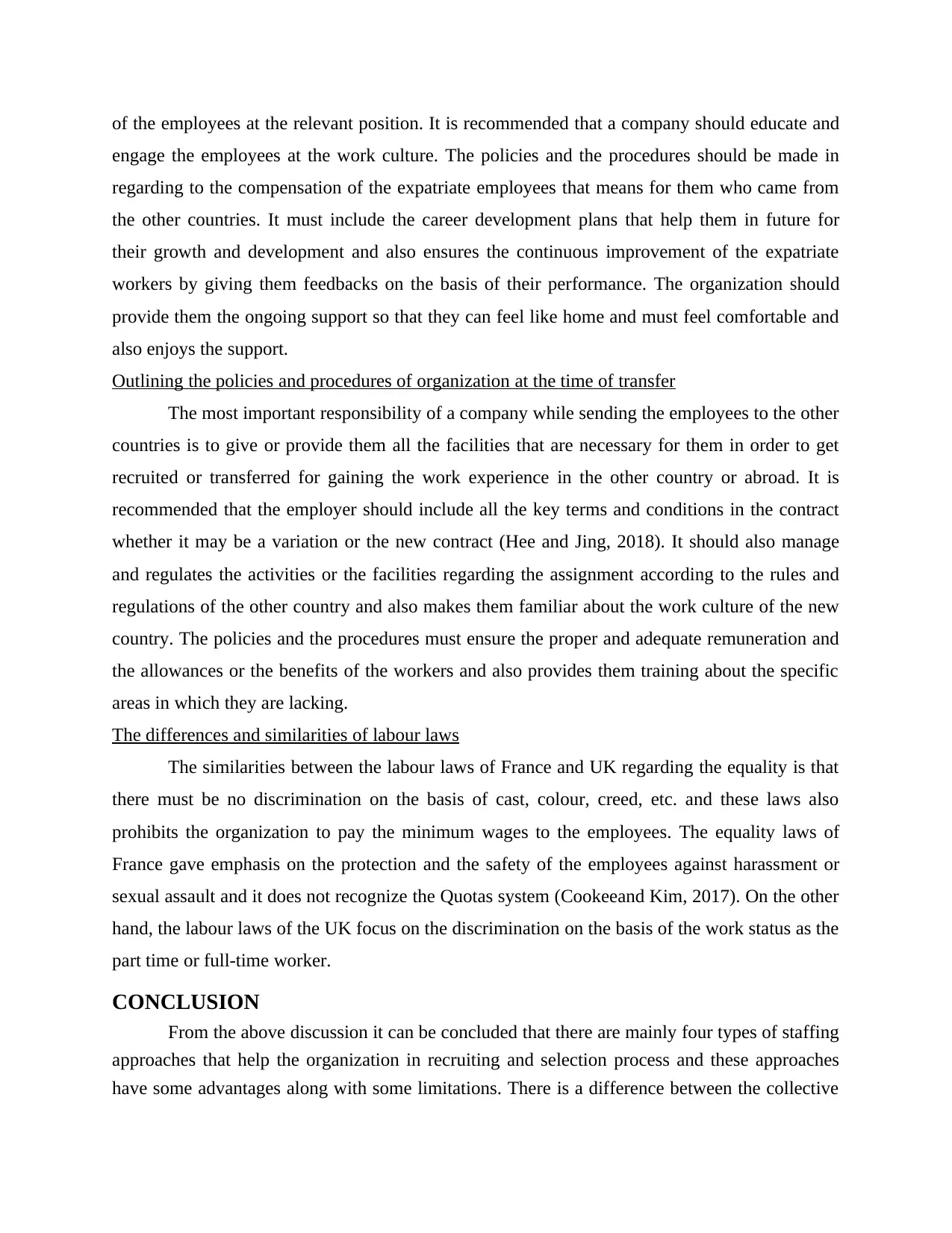
of the employees at the relevant position. It is recommended that a company should educate and
engage the employees at the work culture. The policies and the procedures should be made in
regarding to the compensation of the expatriate employees that means for them who came from
the other countries. It must include the career development plans that help them in future for
their growth and development and also ensures the continuous improvement of the expatriate
workers by giving them feedbacks on the basis of their performance. The organization should
provide them the ongoing support so that they can feel like home and must feel comfortable and
also enjoys the support.
Outlining the policies and procedures of organization at the time of transfer
The most important responsibility of a company while sending the employees to the other
countries is to give or provide them all the facilities that are necessary for them in order to get
recruited or transferred for gaining the work experience in the other country or abroad. It is
recommended that the employer should include all the key terms and conditions in the contract
whether it may be a variation or the new contract (Hee and Jing, 2018). It should also manage
and regulates the activities or the facilities regarding the assignment according to the rules and
regulations of the other country and also makes them familiar about the work culture of the new
country. The policies and the procedures must ensure the proper and adequate remuneration and
the allowances or the benefits of the workers and also provides them training about the specific
areas in which they are lacking.
The differences and similarities of labour laws
The similarities between the labour laws of France and UK regarding the equality is that
there must be no discrimination on the basis of cast, colour, creed, etc. and these laws also
prohibits the organization to pay the minimum wages to the employees. The equality laws of
France gave emphasis on the protection and the safety of the employees against harassment or
sexual assault and it does not recognize the Quotas system (Cookeeand Kim, 2017). On the other
hand, the labour laws of the UK focus on the discrimination on the basis of the work status as the
part time or full-time worker.
CONCLUSION
From the above discussion it can be concluded that there are mainly four types of staffing
approaches that help the organization in recruiting and selection process and these approaches
have some advantages along with some limitations. There is a difference between the collective
engage the employees at the work culture. The policies and the procedures should be made in
regarding to the compensation of the expatriate employees that means for them who came from
the other countries. It must include the career development plans that help them in future for
their growth and development and also ensures the continuous improvement of the expatriate
workers by giving them feedbacks on the basis of their performance. The organization should
provide them the ongoing support so that they can feel like home and must feel comfortable and
also enjoys the support.
Outlining the policies and procedures of organization at the time of transfer
The most important responsibility of a company while sending the employees to the other
countries is to give or provide them all the facilities that are necessary for them in order to get
recruited or transferred for gaining the work experience in the other country or abroad. It is
recommended that the employer should include all the key terms and conditions in the contract
whether it may be a variation or the new contract (Hee and Jing, 2018). It should also manage
and regulates the activities or the facilities regarding the assignment according to the rules and
regulations of the other country and also makes them familiar about the work culture of the new
country. The policies and the procedures must ensure the proper and adequate remuneration and
the allowances or the benefits of the workers and also provides them training about the specific
areas in which they are lacking.
The differences and similarities of labour laws
The similarities between the labour laws of France and UK regarding the equality is that
there must be no discrimination on the basis of cast, colour, creed, etc. and these laws also
prohibits the organization to pay the minimum wages to the employees. The equality laws of
France gave emphasis on the protection and the safety of the employees against harassment or
sexual assault and it does not recognize the Quotas system (Cookeeand Kim, 2017). On the other
hand, the labour laws of the UK focus on the discrimination on the basis of the work status as the
part time or full-time worker.
CONCLUSION
From the above discussion it can be concluded that there are mainly four types of staffing
approaches that help the organization in recruiting and selection process and these approaches
have some advantages along with some limitations. There is a difference between the collective
Paraphrase This Document
Need a fresh take? Get an instant paraphrase of this document with our AI Paraphraser
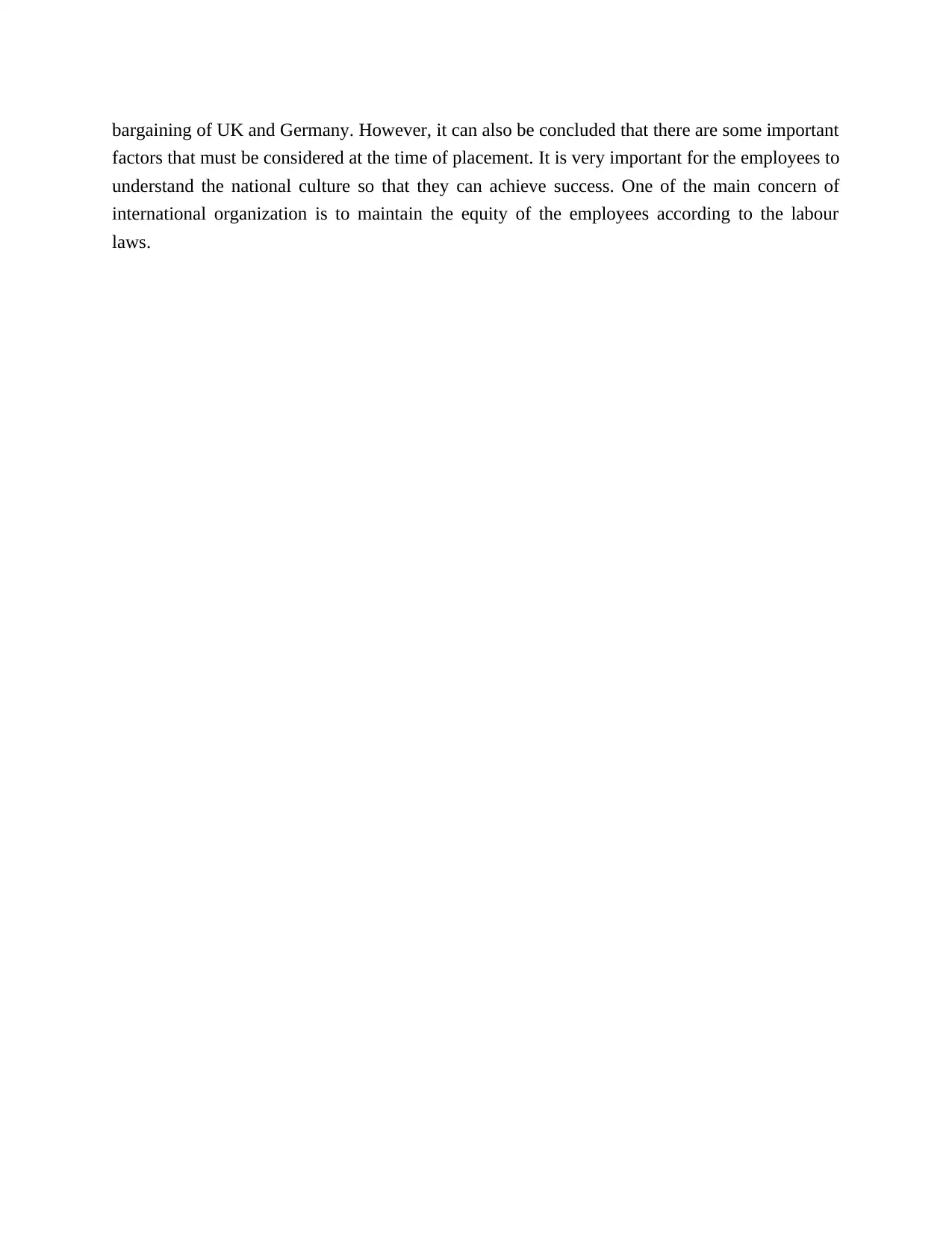
bargaining of UK and Germany. However, it can also be concluded that there are some important
factors that must be considered at the time of placement. It is very important for the employees to
understand the national culture so that they can achieve success. One of the main concern of
international organization is to maintain the equity of the employees according to the labour
laws.
factors that must be considered at the time of placement. It is very important for the employees to
understand the national culture so that they can achieve success. One of the main concern of
international organization is to maintain the equity of the employees according to the labour
laws.
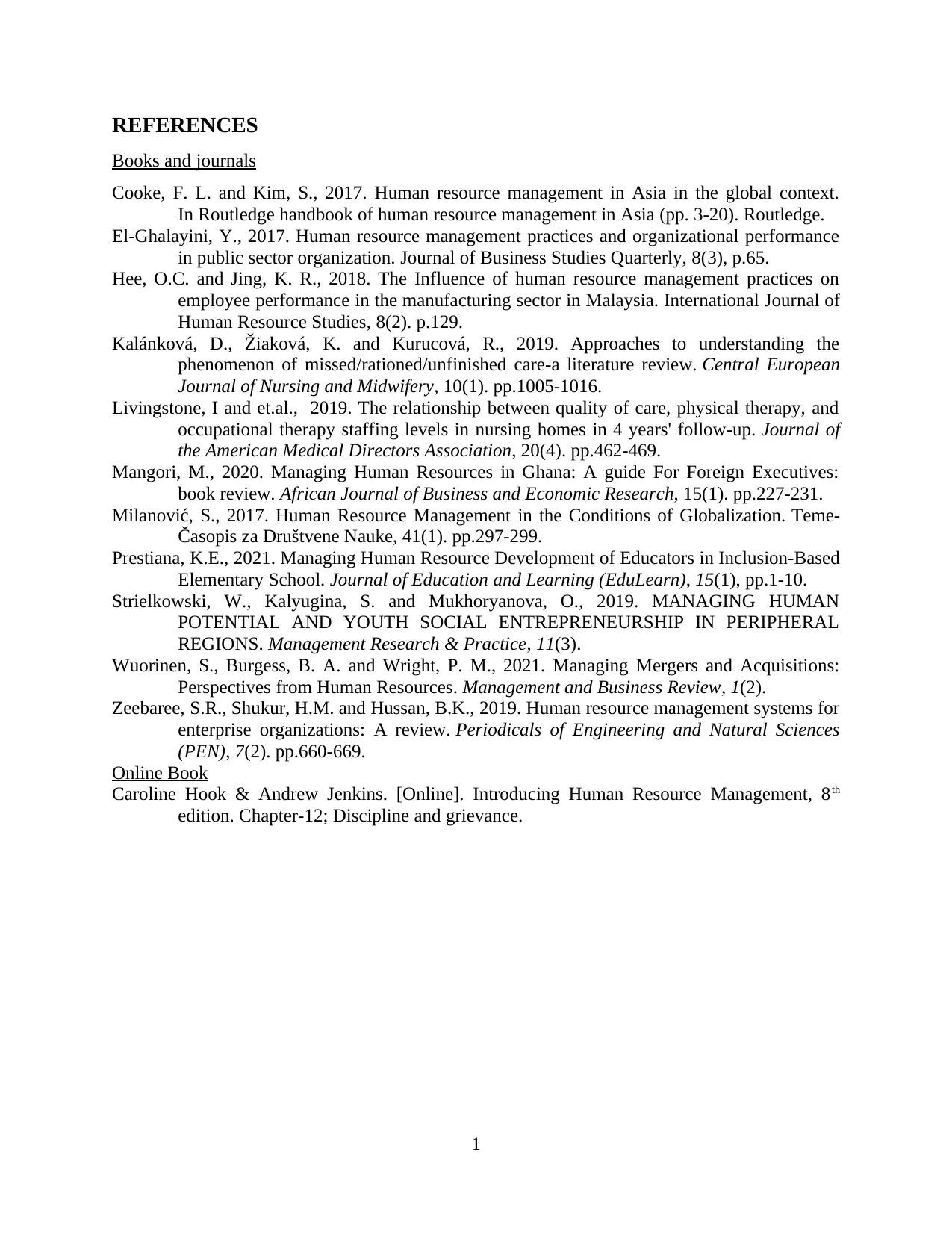
REFERENCES
Books and journals
Cooke, F. L. and Kim, S., 2017. Human resource management in Asia in the global context.
In Routledge handbook of human resource management in Asia (pp. 3-20). Routledge.
El-Ghalayini, Y., 2017. Human resource management practices and organizational performance
in public sector organization. Journal of Business Studies Quarterly, 8(3), p.65.
Hee, O.C. and Jing, K. R., 2018. The Influence of human resource management practices on
employee performance in the manufacturing sector in Malaysia. International Journal of
Human Resource Studies, 8(2). p.129.
Kalánková, D., Žiaková, K. and Kurucová, R., 2019. Approaches to understanding the
phenomenon of missed/rationed/unfinished care-a literature review. Central European
Journal of Nursing and Midwifery, 10(1). pp.1005-1016.
Livingstone, I and et.al., 2019. The relationship between quality of care, physical therapy, and
occupational therapy staffing levels in nursing homes in 4 years' follow-up. Journal of
the American Medical Directors Association, 20(4). pp.462-469.
Mangori, M., 2020. Managing Human Resources in Ghana: A guide For Foreign Executives:
book review. African Journal of Business and Economic Research, 15(1). pp.227-231.
Milanović, S., 2017. Human Resource Management in the Conditions of Globalization. Teme-
Časopis za Društvene Nauke, 41(1). pp.297-299.
Prestiana, K.E., 2021. Managing Human Resource Development of Educators in Inclusion-Based
Elementary School. Journal of Education and Learning (EduLearn), 15(1), pp.1-10.
Strielkowski, W., Kalyugina, S. and Mukhoryanova, O., 2019. MANAGING HUMAN
POTENTIAL AND YOUTH SOCIAL ENTREPRENEURSHIP IN PERIPHERAL
REGIONS. Management Research & Practice, 11(3).
Wuorinen, S., Burgess, B. A. and Wright, P. M., 2021. Managing Mergers and Acquisitions:
Perspectives from Human Resources. Management and Business Review, 1(2).
Zeebaree, S.R., Shukur, H.M. and Hussan, B.K., 2019. Human resource management systems for
enterprise organizations: A review. Periodicals of Engineering and Natural Sciences
(PEN), 7(2). pp.660-669.
Online Book
Caroline Hook & Andrew Jenkins. [Online]. Introducing Human Resource Management, 8th
edition. Chapter-12; Discipline and grievance.
1
Books and journals
Cooke, F. L. and Kim, S., 2017. Human resource management in Asia in the global context.
In Routledge handbook of human resource management in Asia (pp. 3-20). Routledge.
El-Ghalayini, Y., 2017. Human resource management practices and organizational performance
in public sector organization. Journal of Business Studies Quarterly, 8(3), p.65.
Hee, O.C. and Jing, K. R., 2018. The Influence of human resource management practices on
employee performance in the manufacturing sector in Malaysia. International Journal of
Human Resource Studies, 8(2). p.129.
Kalánková, D., Žiaková, K. and Kurucová, R., 2019. Approaches to understanding the
phenomenon of missed/rationed/unfinished care-a literature review. Central European
Journal of Nursing and Midwifery, 10(1). pp.1005-1016.
Livingstone, I and et.al., 2019. The relationship between quality of care, physical therapy, and
occupational therapy staffing levels in nursing homes in 4 years' follow-up. Journal of
the American Medical Directors Association, 20(4). pp.462-469.
Mangori, M., 2020. Managing Human Resources in Ghana: A guide For Foreign Executives:
book review. African Journal of Business and Economic Research, 15(1). pp.227-231.
Milanović, S., 2017. Human Resource Management in the Conditions of Globalization. Teme-
Časopis za Društvene Nauke, 41(1). pp.297-299.
Prestiana, K.E., 2021. Managing Human Resource Development of Educators in Inclusion-Based
Elementary School. Journal of Education and Learning (EduLearn), 15(1), pp.1-10.
Strielkowski, W., Kalyugina, S. and Mukhoryanova, O., 2019. MANAGING HUMAN
POTENTIAL AND YOUTH SOCIAL ENTREPRENEURSHIP IN PERIPHERAL
REGIONS. Management Research & Practice, 11(3).
Wuorinen, S., Burgess, B. A. and Wright, P. M., 2021. Managing Mergers and Acquisitions:
Perspectives from Human Resources. Management and Business Review, 1(2).
Zeebaree, S.R., Shukur, H.M. and Hussan, B.K., 2019. Human resource management systems for
enterprise organizations: A review. Periodicals of Engineering and Natural Sciences
(PEN), 7(2). pp.660-669.
Online Book
Caroline Hook & Andrew Jenkins. [Online]. Introducing Human Resource Management, 8th
edition. Chapter-12; Discipline and grievance.
1
1 out of 9
Related Documents
Your All-in-One AI-Powered Toolkit for Academic Success.
+13062052269
info@desklib.com
Available 24*7 on WhatsApp / Email
![[object Object]](/_next/static/media/star-bottom.7253800d.svg)
Unlock your academic potential
© 2024 | Zucol Services PVT LTD | All rights reserved.



